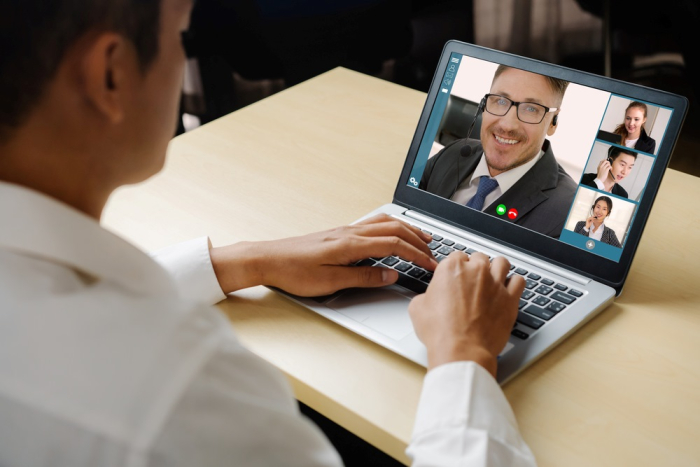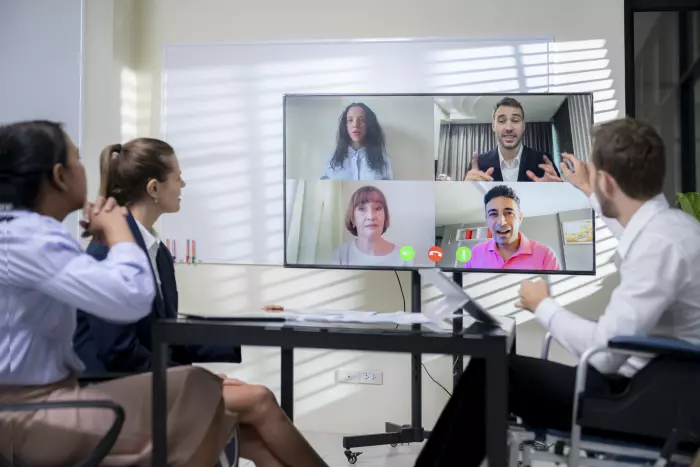The days of rigid adherence to a 9-5 working schedule are long gone. With the aid of broadband connectivity and the latest technology, we can take control of how, and when, we choose to work.
Many of us have revelled in the new flexibility, upping our productivity and wrapping our working day around childcare or familial responsibilities.
Some of us, whose natural rhythms never fully harmonised with the 9-5 routine, have rejoiced in the freedom to work late into the night or at the crack of dawn.
But this brave new world comes at a price. Offices are places where we chat and gossip, make friendships, build teams, and enjoy lunches out and after-work drinks.
They are also ideal spaces for spontaneous meetings, overheard insights, or ad hoc brainstorming sessions.
Hybrid working is designed to exploit the best of both these worlds, freeing employees from the routine working week, but still maintaining a foundation of office life.
With the new emphasis on communicating online here to stay, how should we behave?
Audio-only participation
There are times when a video call just isn’t possible for everyone involved and it is helpful if call organisers allow audio-only participants, who may be travelling for business, or constrained by international time zones or family commitments to join.
It’s important that call organisers are trained to be aware of audio-only participants, to ensure they are included and given the space needed to fully engage with colleagues on video.
If there are audio participants on the call, organisers should be conscious of their presence and ensure they are introduced clearly at the outset.
Meeting participants will need to be vigilant about not talking over each other, especially as they will lack visual clues, such as a raised hand, from audio contributors.
Don’t be alarmed by long pauses and scramble to fill them with chatter; they are an invaluable way of giving people space to interject or expound.
Consider what can be seen behind you
If you’re a hybrid worker dialling into an audio-visual meeting from home, you will need to indulge in a little set-dressing before your call.
Evaluate your video background. It’s fine to show your personality – it is your home, after all – but try to eliminate chaotic bookshelves, discarded clothing, empty takeaway containers and distracting artwork. You want your colleagues to focus on you, not your background.
Test your audio-visual set-up before any hybrid meetings to pre-empt irritating technical glitches. Level the camera with your eyes, not your chin, or you’ll look jowly and distorted.

Ideally, have your eyes level with the camera rather than looking down or up at the screen.
(Image: Depositphotos)
Don’t have a light behind you – you will turn into a silhouette and your colleagues will be staring into a glare.
If you’re in the office, try to find a quiet meeting room for your call, but if you are forced to make it in a communal space, blur your background.
Politely warn your colleagues that you’re making a call, and this should prevent them from moving around behind you, which can be distracting.
Noise control
When attending meetings, using the mute function is considerate if you are making an audio call from a noisy environment – for example, a busy office or a cafe. But you need to be very meticulous about switching the microphone on before you speak.
Remember to mute your phone or headset before you join a call so you won’t be disturbed by ringtones, but also be aware that open and running apps and programs on your computer may disgorge a series of tones and pings that could be distracting.
Camera on/off
If organisers have a preference, they should send a note prior to a meeting clarifying whether they’d like participants to have their camera on.
In general, when joining a hybrid meeting, it is best practice to keep your camera on unless you have a reason not to, for example travelling, poor connectivity, health reasons or dealing with another issue in the background.
This should be explained at the outset. If this is the case, then other meeting attendees should not take offence if cameras are switched off.
In-person punctuality rules also apply for online meetings, so turn up on time for all virtual meetings and don’t leave colleagues waiting.
What to wear
Inevitably, hybrid workers will choose to wear relaxed, comfortable clothing when working from home, but beware of the psychological impact of truly letting yourself go, and how this may look when you are joining video calls.

Video-call participants shouldn't appear too casual, and the use of other devices is a no-no.
(Image: Depositphotos)
You should aim to dress as if you are in the room with other meeting attendees. Aim for neutral clothing, and avoid dressing in non-solid colours, stripes and other patterns that could create a shimmering effect, which can be very distracting.
Offices have inevitably become more relaxed when it comes to dress codes but do remember your public-facing persona when you go in to work and make an effort to look professional for those important meetings where you need to look your best.
On-screen advice
For formal meetings, it’s important to maintain eye contact and not to be distracted by your own image in the corner of the screen.
Use your face to convey expression, and avoid expansive hand gestures.
Sit still, don’t fidget, and avoid fiddling with your face, beard or hair.
Sit up straight, with your shoulders back and your feet planted firmly on the floor.
You can lean into the screen for emphasis, but don’t lean back in your chair.
Make sure to look at the camera when speaking, not at the images on the monitor. That said, the beauty of video calls is that you will be able to read the room and judge whether your body language is appropriate.
There is no need for formality if you observe other participants behaving informally.
If you’re making an audio call, smile when you’re speaking, and people will hear the warmth and friendliness in your voice.
Ending a video call can sometimes feel a bit awkward. To make calls feel more friendly and inclusive, you can soften the abrupt finality of pressing "End call" by giving colleagues a wave goodbye.
Be considerate
If you are making a video call from a laptop or tablet, try to keep it in a fixed position. Don’t carry it downstairs if there’s a knock at the front door, or while you wander around the office – this could give your colleagues a bad dose of motion sickness. It’s better to just make your excuses and step away temporarily.
It’s fine to sip a cup of tea, coffee or another drink, but you should try to avoid eating – you don’t want people to focus on the contents of your lunch rather than what you’re saying.
It’s preferable to eat before you join a meeting, but circumstances such as after-hours international calls may mean this isn’t possible.

It's okay to enjoy a cuppa while on a video call, but inadvisable to be seen eating. (Image: Depositphotos)
Effective time management can be your friend in negotiating these situations. It’s also worth remembering that you are in a meeting. Regardless of whether it is audio or visual, it is inappropriate to do something else for an extended period of time – looking at your phone, for example.
It is also very bad form to carry on working on other tasks while on a call; everybody will realise your mind is elsewhere and can probably hear the incriminating clatter of your keyboard.
Work/leisure separation
When working from home, you are essentially unmonitored and unsupervised, and your house is full of diversions. You may become side-tracked by domestic chores, the garden, or the fridge – if you feel like procrastinating or are gearing yourself up to make a difficult call, it is all too easy to wander into the kitchen for a quick snack or cup of coffee.
It is important to compartmentalise work time and leisure time so you don’t allow the domestic world to impinge on your working environment.

Having a dedicated work area away from the rest of your household is ideal. (Image: Depositphotos)
Creating a dedicated physical space for work and adhering to your own working timetable will help you to feel focused and productive.
Additionally, if you’re making audio or video calls from home, you should try to find a room away from the rest of the household.
Ensure that everyone is aware that your room is off-bounds and that you must not be interrupted.
Impress on your flatmates, partner or family that loud shouting, a radio playing, or pounding music may be audible.
Focus on work
Hybrid workers may well bring home habits into the office, not all of them congenial. You may feel uninhibited about heating up strong-smelling food in the communal kitchen or relaxed about sprawling in your chair and shouting down the phone.
You may find yourself prone to prolonged catch-up chats on office days and come away feeling unfocused, perhaps slightly overwhelmed by a noisy, diverting, peopled office after the isolation of home.
Guard against wasting your office days by planning ahead, scheduling meetings, booking a meeting room and embracing the chance to exchange ideas and ask focused questions face-to-face.
Joining calls while in the office is also challenging, often due to noise. It is quite acceptable to politely ask your colleagues to keep their voices down and to turn down their radio or music when you’re on an important audio or visual call.
Private time
The easing of our working parameters has created a different attitude to office time. Hybrid workers may have created their own timetable, which does not necessarily align with more conventional working days.
This flexibility should be accommodated, but it is also important to ensure a 24/7 working culture doesn’t sneak in by the back door; it shouldn’t be assumed that, just because employees are home-based, they are always available.
To avoid demands being made at all hours of the day and night in an office culture that does not adhere to conventional working hours, keep everybody aware of your availability by using "out-of-office" notifications, or explanations of working hours and contact numbers on your email footer.
It is also important to schedule regular online meetings for catch-ups with remote colleagues. This will ensure that they feel included in all major decisions and updates and will not fear that hybrid work is impeding their career progression.

Just because a staffer is working from home doesn't mean they're at the beck and call of the office 24/7.
(Image: Depositphotos)
Hot-desking
In this hybrid era, you may well find yourself asked to hot-desk – employers may not want to dedicate permanent office space to those who come in only once or twice a week.
Don’t assume that the lack of an allocated desk means that you are being undervalued; recognise it as a practical decision and make the best of it.
You may find yourself assigned to a new part of the office, with an opportunity to meet different people and exchange new ideas.
Employ good hot-desk etiquette: leave everything exactly as you found it; give the computer and screen a quick wipe; check that you have not left coffee-mug rings or food debris in any hidden nooks or crannies; remove all your personal possessions, and don’t pinch the Post-its or pens.
And if the covid era has taught us anything, it is that we should take sickness seriously. Don’t struggle into the office if you’ve got a cough or cold or anything contagious. Nobody will applaud your stoicism.
Conclusion
Hybrid working is here to stay and the new flexibility around working patterns has had a transformational and liberating impact on many people’s lives.
Good hybrid-working etiquette will ensure that you are able to stay focused and productive, using the full power of audio and visual technology to communicate with your colleagues and contribute to office culture.










